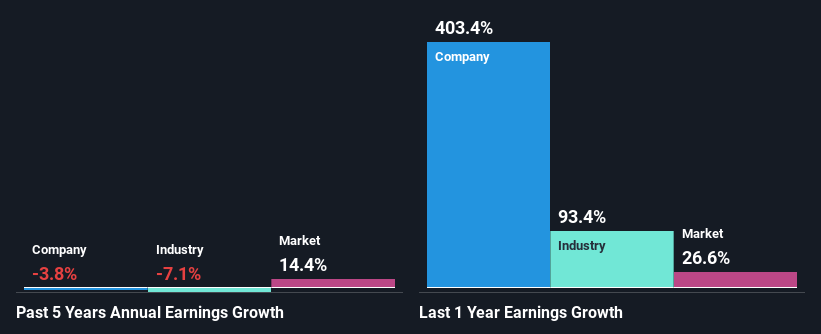VOC Energy Trust (NYSE:VOC) Is Going Strong But Fundamentals Appear To Be Mixed : Is There A Clear Direction For The Stock?
VOC Energy Trust (NYSE:VOC) has had a great run on the share market with its stock up by a significant 39% over the last three months. However, we wonder if the company's inconsistent financials would have any adverse impact on the current share price momentum. Particularly, we will be paying attention to VOC Energy Trust's ROE today.
Return on equity or ROE is an important factor to be considered by a shareholder because it tells them how effectively their capital is being reinvested. Put another way, it reveals the company's success at turning shareholder investments into profits.
View our latest analysis for VOC Energy Trust
How To Calculate Return On Equity?
Return on equity can be calculated by using the formula:
Return on Equity = Net Profit (from continuing operations) ÷ Shareholders' Equity
So, based on the above formula, the ROE for VOC Energy Trust is:
80% = US$12m ÷ US$16m (Based on the trailing twelve months to March 2022).
The 'return' is the yearly profit. That means that for every $1 worth of shareholders' equity, the company generated $0.80 in profit.
What Is The Relationship Between ROE And Earnings Growth?
We have already established that ROE serves as an efficient profit-generating gauge for a company's future earnings. Based on how much of its profits the company chooses to reinvest or "retain", we are then able to evaluate a company's future ability to generate profits. Generally speaking, other things being equal, firms with a high return on equity and profit retention, have a higher growth rate than firms that don’t share these attributes.
VOC Energy Trust's Earnings Growth And 80% ROE
To begin with, VOC Energy Trust has a pretty high ROE which is interesting. Secondly, even when compared to the industry average of 18% the company's ROE is quite impressive. As you might expect, the 3.8% net income decline reported by VOC Energy Trust doesn't bode well with us. So, there might be some other aspects that could explain this. Such as, the company pays out a huge portion of its earnings as dividends, or is faced with competitive pressures.
We then compared VOC Energy Trust's performance with the industry and found that the company has shrunk its earnings at a slower rate than the industry earnings which has seen its earnings shrink by 7.1% in the same period. This does appease the negative sentiment around the company to a certain extent.
Earnings growth is a huge factor in stock valuation. What investors need to determine next is if the expected earnings growth, or the lack of it, is already built into the share price. This then helps them determine if the stock is placed for a bright or bleak future. Is VOC Energy Trust fairly valued compared to other companies? These 3 valuation measures might help you decide.
Is VOC Energy Trust Making Efficient Use Of Its Profits?
VOC Energy Trust has a high three-year median payout ratio of 97% (that is, it is retaining 2.7% of its profits). This suggests that the company is paying most of its profits as dividends to its shareholders. This goes some way in explaining why its earnings have been shrinking. The business is only left with a small pool of capital to reinvest - A vicious cycle that doesn't benefit the company in the long-run. Our risks dashboard should have the 3 risks we have identified for VOC Energy Trust.
In addition, VOC Energy Trust has been paying dividends over a period of at least ten years suggesting that keeping up dividend payments is way more important to the management even if it comes at the cost of business growth.
Summary
In total, we're a bit ambivalent about VOC Energy Trust's performance. While the company does have a high rate of return, its low earnings retention is probably what's hampering its earnings growth. So far, we've only made a quick discussion around the company's earnings growth. To gain further insights into VOC Energy Trust's past profit growth, check out this visualization of past earnings, revenue and cash flows.
Have feedback on this article? Concerned about the content? Get in touch with us directly. Alternatively, email editorial-team (at) simplywallst.com.
This article by Simply Wall St is general in nature. We provide commentary based on historical data and analyst forecasts only using an unbiased methodology and our articles are not intended to be financial advice. It does not constitute a recommendation to buy or sell any stock, and does not take account of your objectives, or your financial situation. We aim to bring you long-term focused analysis driven by fundamental data. Note that our analysis may not factor in the latest price-sensitive company announcements or qualitative material. Simply Wall St has no position in any stocks mentioned.

 Yahoo Finance
Yahoo Finance 
